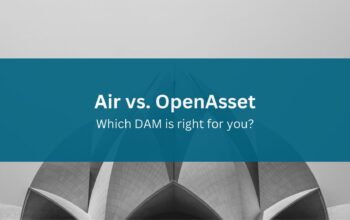In the US, marketing teams in mid to enterprise-level construction firms are often dispersed, spread out across multiple cities. While each team manages their own localized marketing requirements, they also rely heavily on a central marketing team and its assets. However, the dispersed marketing model, common to the construction sector, is a complicated configuration to manage. Marketing leaders face the challenge of creating the optimal marketing team structure. Whichever structure is chosen, every team member needs access to the marketing materials they need, when they need them. This ensures efficiency, consistency, and relevancy of all marketing communications.
What is the Current State of Marketing in the Construction Industry?
Marketing in the construction industry has seen somewhat of a revolution in recent years. More time, effort, and resource is being allocated to marketing strategy, and that is forcing change. The silos that used to exist between sales and marketing are breaking down, resulting in far more collaboration and aligned thinking.
Digital marketing has come to the forefront to support new ways of working, albeit later than for most other industries. This means that sales teams can focus on what they do best, closing deals instead of losing time searching for contact information. Meanwhile, marketing methods are shifting from cold-calling and direct mail towards social media and email marketing with a focus on building client trust.
However, while change is happening, many construction businesses still don’t have a Customer Relationship Management (CRM) system, a predictable lead generation strategy, or a marketing plan. The problem with this is that developers and landowners are using digital tools to search before engaging with sales teams. Marketing is fundamental if construction businesses are to remain competitive.
The Challenges of Dispersed Marketing Teams

While it is prevalent for marketing teams to be split across various offices and cities, dispersed marketing teams create several business challenges. Teams need to be able to work independently but also to collaborate across offices. Frequent challenges include:
- Creating a unified brand image
- Aligning key messages
- Enabling collaboration
- Sharing a single source of truth
- Encouraging communication
The Pros and Cons of Centralized and Decentralized Marketing
A centralized marketing team means that all of the skills, resources, and systems are in one place. With this more simple model, activities can be streamlined and more cost-effective. As well as delivering economies of scale, it is a lot easier to create a unified marketing approach with ownership and accountability over every piece of marketing material produced. However, the centralized approach hinders the ability to tailor products locally and can stifle innovation. This is especially relevant to the construction industry, where the need to customize on a local level can make a significant difference.
Decentralized marketing teams, on the other hand, enable each locality to create marketing collateral without the interference from ‘head office’. Marketers can use their local knowledge and offer a higher level of customization and improved customer communications. However, the biggest challenge that comes with a decentralized approach is that different systems, strategies, and campaigns evolve. The disconnect can threaten brand integrity, create complicated workflows, and can create a duplication of work.
The key to managing dispersed teams is to create the right blend of these two models. There needs to be control and governance that comes from a centralized team but with the agility and creativity that local teams thrive on. The distributed marketing model is a viable approach in the construction industry. The central team can maintain control of the brand and develop core assets, but local teams have the freedom to customize and localize the assets to suit their needs. A distributed marketing team, in this way, ensures that workflows are improved, systems are consistent across all teams, and data is stored centrally.
How to Manage Decentralized Teams
Managing dispersed teams is no mean feat, and with a considerable rise in remote workers, the challenge is only growing. Marketing team leaders need to find ways to connect teams, regardless of distance. Create policies and practices to ensure dispersed teams feel part of the company community and committed to the overall business goals. Some methods to help manage decentralized teams include:
- Building context – there needs to be a greater context to marketing campaigns and projects so each individual understands their role and why it matters. The sense that everyone is working towards a greater purpose helps to increase engagement and productivity.
- Improving communication – when teams aren’t working side by side, communication is fundamental. Emails can be misunderstood, and individuals can quickly feel out of the loop. With dispersed teams, communication should be ramped up with frequent use of video chat and video conferencing tools.
- Embracing technology – as well as using technology to enhance communication, tools, and systems can be used to centralize assets, streamline project management, and manage customer relations.
The Use of Technology In Construction Marketing Teams
Marketing technology is an incredibly powerful tool that can go a long way towards solving the challenges of dispersed teams in multiple offices. What’s more, technology lends itself to the project-centric nature of the construction industry. Tech creates improved workflows and a connection between all of a firm’s digital assets and the people who need to use them.
There is a considerable choice of Software as a Service (SaaS) solutions available to marketing teams in the construction sector. Each offers its own set of benefits such as managing client databases, organizing digital assets, and automating lead nurturing. However, the key is to create the right blend of technologies. A successful tech stack is a culmination of technologies that work together seamlessly to become more than the sum of their parts. An integrated tech stack will include critical components such as:
- Digital Asset Management (DAM) – for storing, organizing and managing all of a firm’s digital assets
- Enterprise Resource Planning (ERP) – for managing, integrating, and automating business processes.
- Construction Project Management (CPM) – for managing construction project processes, tasks, documents, comms, and materials
- Customer Relationship Management (CRM) – for providing in-depth insight into a firm’s customer base.
- Knowledge management – for enabling internal knowledge to be shared across the history of a firm’s projects.
- Marketing automation – for automating targeted marketing messages to high-potential leads.
By using the right mix of technology, dispersed marketing teams can improve their project focus, target leads more effectively, and increases efficiency. More importantly, with dispersed teams, technology can help streamline workflows and processes across multiple offices.
With the right tech stack, construction firms can be confident that the whole team, regardless of location, is working with up-to-date, on-brand materials. Teams will have all of the tools at their fingertips to get the very best return on investment for every campaign.



